

Aarne–Thompson–Uther Index. Index used to classify folk narratives The Aarne–Thompson–Uther Index (ATU Index) is a catalogue of folktale types used in folklore studies.
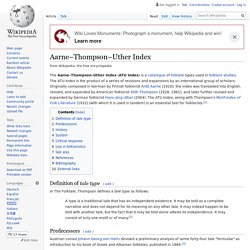
The ATU Index is the product of a series of revisions and expansions by an international group of scholars: Originally composed in German by Finnish folklorist Antti Aarne (1910); the index was translated into English, revised, and expanded by American folklorist Stith Thompson (1928, 1961); and later further revised and expanded by German folklorist Hans-Jörg Uther (2004). The ATU Index, along with Thompson's Motif-Index of Folk-Literature (1932) (with which it is used in tandem) is an essential tool for folklorists.[1] Definition of tale type[edit] In The Folktale, Thompson defines a tale type as follows: A type is a traditional tale that has an independent existence.
Thule. In classical and medieval literature, ultima Thule (Latin "farthermost Thule") acquired a metaphorical meaning of any distant place located beyond the "borders of the known world".[5] By the Late Middle Ages and early modern period, the Greco-Roman Thule was often identified with the real Iceland or Greenland.
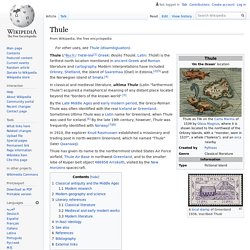
Sometimes Ultima Thule was a Latin name for Greenland, when Thule was used for Iceland.[6] By the late 19th century, however, Thule was frequently identified with Norway.[7][8] In 1910, the explorer Knud Rasmussen established a missionary and trading post in north-western Greenland, which he named "Thule" (later Qaanaaq). Hyperborea. Cassandra (metaphor) Metaphor originating from Greek mythology The Cassandra metaphor (variously labeled the Cassandra "syndrome", "complex", "phenomenon", "predicament", "dilemma", "curse") relates to a person whose valid warnings or concerns are disbelieved by others.

Janus. Roman god of beginnings and doorways Janus had no flamen or specialised priest (sacerdos) assigned to him, but the King of the Sacred Rites (rex sacrorum) himself carried out his ceremonies.
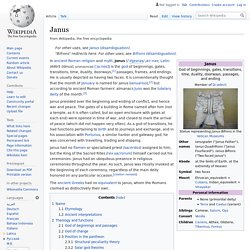
Janus had an ubiquitous presence in religious ceremonies throughout the year. As such, Janus was ritually invoked at the beginning of each ceremony, regardless of the main deity honored on any particular occasion. Icarus. Icarus and Daedalus ancient red relief plastic pottery beaker, Roman-Greece In Greek mythology, Icarus (the Latin spelling, conventionally adopted in English; Ancient Greek: Ἴκαρος, Íkaros, Etruscan: Vikare[1]) is the son of the master craftsman Daedalus, the creator of the Labyrinth.
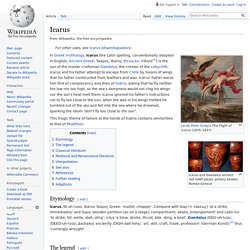
Icarus and his father attempt to escape from Crete by means of wings that his father constructed from feathers and wax. Icarus' father warns him first of complacency and then of hubris, asking that he fly neither too low nor too high, so the sea's dampness would not clog his wings nor the sun's heat melt them. Phaethon. Mythology[edit] Phaethon, challenged by Epaphus and his playmates, sought assurance from his mother that his father was the sun god Helios.
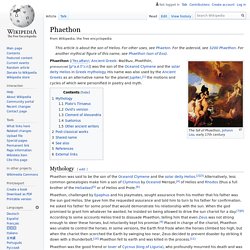
She gave him the requested assurance and told him to turn to his father for confirmation. He asked his father for some proof that would demonstrate his relationship with the sun. When the god promised to grant him whatever he wanted, he insisted on being allowed to drive the sun chariot for a day.[7][8] According to some accounts Helios tried to dissuade Phaethon, telling him that even Zeus was not strong enough to steer these horses, but reluctantly kept his promise.[9] Placed in charge of the chariot, Phaethon was unable to control the horses.
Sophocles. Ancient Athenian tragic playwright Life[edit] A marble relief of a poet, perhaps Sophocles Sophocles, the son of Sophilus, was a wealthy member of the rural deme (small community) of Hippeios Colonus in Attica, which was to become a setting for one of his plays, and he was probably born there.[2][7] Sophocles was born a few years before the Battle of Marathon in 490 BC: the exact year is unclear, although 497/6 is the most likely.[2][8] Sophocles was born into a wealthy family (his father was an armour manufacturer) and was highly educated.
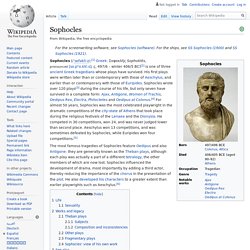
Sophocles' first artistic triumph was in 468 BC, when he took first prize in the Dionysia theatre competition over the reigning master of Athenian drama, Aeschylus.[2][9] According to Plutarch, the victory came under unusual circumstances. Namas Te. Rigveda. First of the four sacred canonical texts (śruti) of Hinduism Rigveda (padapatha) manuscript in Devanagari, early 19th century.
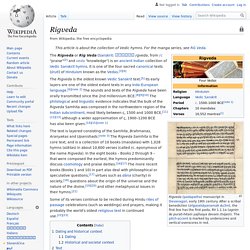
Book of Enoch. Hebrew religious text, ascribed to Enoch The older sections (mainly in the Book of the Watchers) of the text are estimated to date from about 300–200 BC, and the latest part (Book of Parables) probably to 100 BC.[3] It is not part of the biblical canon used by Jews, apart from Beta Israel (Ethiopian Jews).
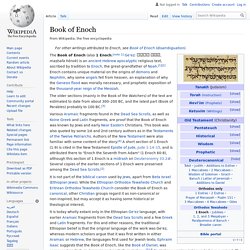
While the Ethiopian Orthodox Tewahedo Church and Eritrean Orthodox Tewahedo Church consider the Book of Enoch as canonical, other Christian groups regard it as non-canonical or non-inspired, but may accept it as having some historical or theological interest. Exploring the Theory that a Modern Image of Jesus was Based on a Pope's Son. When you’re looking for a real-life model for Jesus Christ, you’d be hard pushed to think of a less appropriate stand-in for the Prince of Peace than Cesare Borgia.
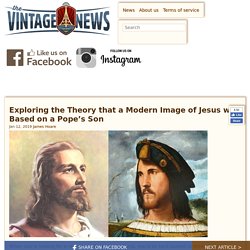
One of the most notorious members of Renaissance Italy’s most notorious dynasties, the cruel Cesare was thought to be the inspiration for Niccolo Machiavelli’s satirical handbook for would-be tyrants, The Prince. Jesus in art Thanks to his father – who became Pope Alexander VI in 1471 – Cesare was made a bishop at the age of 15 and a cardinal at the age of 18. At this point in history the Pope directly ruled over a kingdom that dominated central Italy from its capital of Rome.
Anunnaki. Group of ancient Mesopotamian deities Four copper-alloy foundation figures depicting ancient Mesopotamian gods wearing characteristic horned crowns (c. 2130 BC) Om. Sacred sound and spiritual symbol in Hinduism, Buddhism Om sound 136,10 Hz Cis - Vibrating tuning fork with resonance body. Ajna. Ajna (Sanskrit: आज्ञा, IAST: Ājñā, IPA: [aːɟɲaː]), guru chakra or third-eye chakra, is the sixth primary chakra in the body according to Hindu tradition.[1][2][3] It is supposedly a part of the brain which can be made more powerful through meditation, yoga and other spiritual practices[4][5] just as a muscle is.
In Hindu tradition, it signifies the subconscious mind, the direct link to the brahman. While a person's two eyes see the physical world, the third eye is believed to reveal insights about the future. The third eye chakra is said to connect people to their intuition, give them the ability to communicate with the world, or help them receive messages from the past and the future.[6][7][8][9][10] Location[edit] Appearance[edit] Brahman. Not to be confused with Brahma, the Hindu god, or brahmin, the caste or varna.
In Hinduism, Brahman (/ˈbrɑːmən/; Sanskrit: ब्रह्मन् brahman) is "the unchanging reality amidst and beyond the world",[1] which "cannot be exactly defined". It has been described in Sanskrit as Sat-cit-ānanda (being-consciousness-bliss) and as the highest reality. [note 1][note 2] Brahman is a Vedic Sanskrit word, and is conceptualized in Hinduism, states Paul Deussen, as the "creative principle which lies realized in the whole world".[7] Understanding the concept of Brahman[edit] The Cloud of Unknowing Index. Sacred Texts Christianity Buy this Book at Amazon.com Contents Start Reading Page Index Text [Zipped] The Cloud of Unknowing. Habil ve Kabil - Vikipedi. Kabil'in Habil'i ölüme götürüşü, James Tissot'un tablosu.
Kabil (Musevi kaynaklarında Kain, Kayn, Kayin) ile Habil (Musevi kaynaklarında Hevel), Tanah'ta, Eski Ahit'te, Kur'an'da ve hadislerde bahsi geçen dini şahsiyetler. Cain and Abel. Cain and Abel. The Metamorphoses of the Pygmalion Myth: A Narrative Critique of Lars and the Real Girl. Pygmalion (play) A Sketch Magazine illustration of Mrs. Patrick Campbell as Eliza Doolittle from 22 April 1914. Shaw wrote the part of Eliza expressly for Campbell, who played opposite Herbert Beerbohm Tree as Henry Higgins. Sortes Vergilianae. History[edit] The Book of Ben Sira.
Icarus. Learn Your Mayan Sign. Today is your spiritual birthday. Eternal return. Ishvara - Wikipedia. Women in Ancient Greece. Women in the ancient Greek world had few rights in comparison to male citizens. Queer Culture Collection. Planet X Nibiru and the Anunnaki of Sumerian Mythology. Thrice-Greatest Hermes, Vol. 1: XI. Concerning the Æon-Doctrine. Abraxas - Wikipedia. Lesya - Wikipedia. Jain cosmology - Wikipedia. Recurring themes in mythology. Shakuntala. Kalidasa: Shakuntala and Other Works: Introduction.
Kālidāsa - Wikipedia. Shakuntala (play) - Wikipedia. Indian Literature: How Kalidas Reached Germany. Mahabharata - Wikipedia. Shakuntala - Wikipedia. Hermit - Wikipedia. Nymph - Wikipedia.